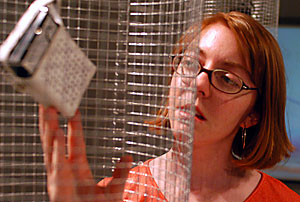 |
|
JACOB KONST/Arizona Daily Wildcat
|
Christina Hiett, art history senior, becomes an antenna for the radio in the Lionel Rombach Gallery yesterday. The show was a joint project between Hiett and nondegree-seeking graduate student Christopher DiScenza.
|
|
|
By Gabe Joselow
Arizona Daily Wildcat
Wednesday, April 14, 2004
Print this
Christina Hiett and Christopher DiScenza don't always think alike. Hiett is an art history senior with a studio art minor graduating in May, and DiScenza graduated with a math degree and physics minor two years ago. But the couple has bridged the gap between two disciplines that are traditionally at odds with one another: physics and art.
Their installation at the Lionel Rombach Gallery on the corner of North Park Avenue and East Speedway Boulevard, called "MHDPD ¸ Magno Hydro Dynamic Propulsion Devise: The Experiment/the Attenuations," features a video of the propulsion device. It was built by DiScenza, channeling and mixing food coloring in a saltwater fish tank.
DiScenza's intention wasn't to call the experiment artwork until Hiett found it.
"I stumbled on these guys in the garage," she said. "They were down on the ground taking photographs of this weird concoction in a fish tank. I saw the photographs and said, ╬This is gorgeous and I want to see this blown up.'"
 |
|
The equations are kind of the deeper meaning behind the art. ¸ Christopher DiScenza, non degre
-seeking graduate student
|
 |
The resulting video projection of the experiment is a cloud of colors undulating, billowing and dissipating at mesmerizing lava-lamp speed through the mysteriously silhouetted propulsion device.
The exhibit's placement within an art gallery assumes an emphasis on the aesthetics, but it was important for Hiett and DiScenza to highlight the science behind it all.
"I'm all about the aesthetics. It's got to be balanced, its got to look right; whereas (DiScenza's) all about the meaning."
The only conflict that their collaboration presented was in compromising on how much of the show was going to be about physics and how much about art.
"There were clashes where I said, ╬This looks good.' And he was like, ╬That doesn't make sense,'" Hiett said.
But for DiScenza, meaning is important, and something he finds lacking in most contemporary art.
"She drags me to a lot of art shows," he said, "and I get tired of seeing just a plain canvas painted all orange. And it's been done, and I keep seeing it. I thought it would be nice to take these physics demonstrations that most people don't see, and sort of force them to look at it. And they think they're looking at art, but they're really kind of learning something."
One of the other pieces in the exhibit, printouts of wave equations on Mylar sheets, shows another unexpected compromise between art and physics. Hiett and DiScenza decided to hang them for very different reasons.
"The equations are kind of the deeper meaning behind the art," DiScenza said.
But for Hiett, they have another meaning. "To me, the equations are very beautiful," she said. "Because it's a language that only very few people understand."
Another piece in the exhibit is a collection of eight transistor radios hanging in separate wire cages, known as Ferriday cages. The cage blocks the radio's signal so they are silent when you first approach them. But instructions on the floor bid you to "Be An Antenna ¸ Touch A Radio." This allows the signal to get through. And when it does, the radios come on ¸ and they are loud.
The interactive nature of this part of the exhibit was an important aspect for the two.
"I have physics envy," Hiett said. "I go into the physics lab and I have this drive to touch things, but I'm not allowed to because I don't have the knowledge to. (DiScenza) knows what he's doing, and he explains it really well, but the end result is always more fun to play with."
The couple collaborated on a previous series of Hiett's paintings based on DiScenza's set theory diagrams. The two took mathematics, made it into art and hung it on the wall. But now they have brought the physics lab into the museum, and crossed a line that few artists (or physicists) are willing to cross.
"(Hiett's) medieval art professor came to me and said, ╬It's interesting, but it's not art.' And I said, ╬You're right; it's physics. Ě Don't tell anybody,'" DiScenza said.

